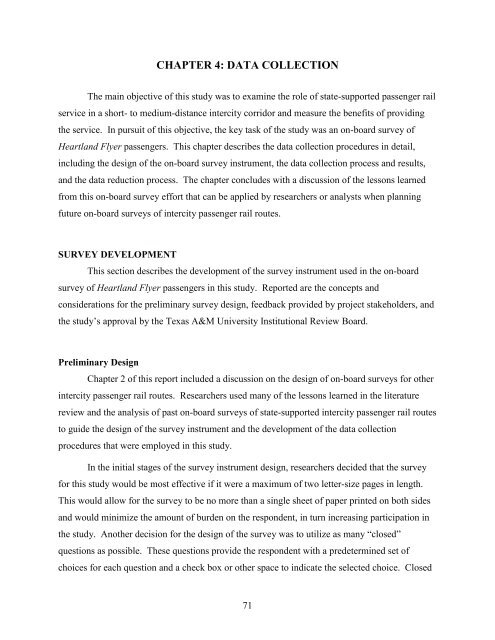Measuring the Benefits of Intercity Passenger Rail: A Study
Measuring the Benefits of Intercity Passenger Rail: A Study
Measuring the Benefits of Intercity Passenger Rail: A Study
Create successful ePaper yourself
Turn your PDF publications into a flip-book with our unique Google optimized e-Paper software.
CHAPTER 4: DATA COLLECTION<br />
The main objective <strong>of</strong> this study was to examine <strong>the</strong> role <strong>of</strong> state-supported passenger rail<br />
service in a short- to medium-distance intercity corridor and measure <strong>the</strong> benefits <strong>of</strong> providing<br />
<strong>the</strong> service. In pursuit <strong>of</strong> this objective, <strong>the</strong> key task <strong>of</strong> <strong>the</strong> study was an on-board survey <strong>of</strong><br />
Heartland Flyer passengers. This chapter describes <strong>the</strong> data collection procedures in detail,<br />
including <strong>the</strong> design <strong>of</strong> <strong>the</strong> on-board survey instrument, <strong>the</strong> data collection process and results,<br />
and <strong>the</strong> data reduction process. The chapter concludes with a discussion <strong>of</strong> <strong>the</strong> lessons learned<br />
from this on-board survey effort that can be applied by researchers or analysts when planning<br />
future on-board surveys <strong>of</strong> intercity passenger rail routes.<br />
SURVEY DEVELOPMENT<br />
This section describes <strong>the</strong> development <strong>of</strong> <strong>the</strong> survey instrument used in <strong>the</strong> on-board<br />
survey <strong>of</strong> Heartland Flyer passengers in this study. Reported are <strong>the</strong> concepts and<br />
considerations for <strong>the</strong> preliminary survey design, feedback provided by project stakeholders, and<br />
<strong>the</strong> study’s approval by <strong>the</strong> Texas A&M University Institutional Review Board.<br />
Preliminary Design<br />
Chapter 2 <strong>of</strong> this report included a discussion on <strong>the</strong> design <strong>of</strong> on-board surveys for o<strong>the</strong>r<br />
intercity passenger rail routes. Researchers used many <strong>of</strong> <strong>the</strong> lessons learned in <strong>the</strong> literature<br />
review and <strong>the</strong> analysis <strong>of</strong> past on-board surveys <strong>of</strong> state-supported intercity passenger rail routes<br />
to guide <strong>the</strong> design <strong>of</strong> <strong>the</strong> survey instrument and <strong>the</strong> development <strong>of</strong> <strong>the</strong> data collection<br />
procedures that were employed in this study.<br />
In <strong>the</strong> initial stages <strong>of</strong> <strong>the</strong> survey instrument design, researchers decided that <strong>the</strong> survey<br />
for this study would be most effective if it were a maximum <strong>of</strong> two letter-size pages in length.<br />
This would allow for <strong>the</strong> survey to be no more than a single sheet <strong>of</strong> paper printed on both sides<br />
and would minimize <strong>the</strong> amount <strong>of</strong> burden on <strong>the</strong> respondent, in turn increasing participation in<br />
<strong>the</strong> study. Ano<strong>the</strong>r decision for <strong>the</strong> design <strong>of</strong> <strong>the</strong> survey was to utilize as many “closed”<br />
questions as possible. These questions provide <strong>the</strong> respondent with a predetermined set <strong>of</strong><br />
choices for each question and a check box or o<strong>the</strong>r space to indicate <strong>the</strong> selected choice. Closed<br />
71
















